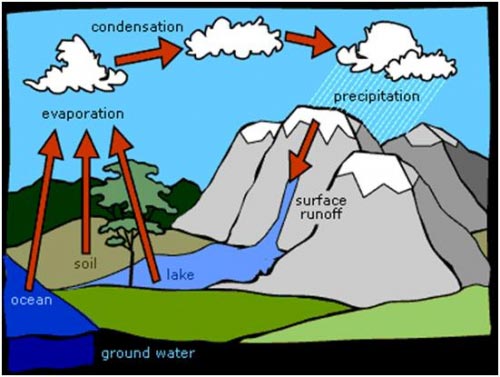What happens to the rain after it hits the ground? Where does it go? Where did it come from? Let’s start at the beginning!
We don’t lose or gain any water. The water that we have we got when the earth was just being formed. This means that the water in your cup has been around for many hundreds of millions of years. It gets recycled through a process called the water cycle.
1. Evaporation
Have you ever left a glass of water out on the table for a few days before? If so, did you notice all of the water slowly disappear? This is called evaporation. The liquid water is turning to gas and floating away!
The evaporated water floats up into the sky and collects with small pieces of dust. When the water and the dust collect, they form clouds in the sky.
Transpiration
Lakes, rivers and open cups of water aren’t the only places that the clouds get water from.
Water also comes from plants! The plants take water out of the ground through their roots and then they “sweat” through their leaves! This is called transpiration!
2. Condensation
When the water is in the clouds it can’t stay in its gas form for long. It is cold high up in the sky, so the water turns back into liquid. This process is called condensation.
3. Precipitation
Clouds can only hold so much water. When they get really full then precipitation happens.
Precipitation can be rain, snow, hail, sleet, or any other kind of water that falls from the sky.
4. Ground Water and Runoff
But where does the water go when it hits the ground? That’s a harder question to answer.
When the rain hits cement, like when it lands on a road or a sidewalk, then it stays in one place and collects in a puddle. This is why we have storm drains on the side of the road for the water to go into. They give all of the water a place to go so that our roads don’t get too flooded. These storm drains collect the water and then release it into streams, lakes, rivers and oceans. We have to be very careful about what we put in these drains because the fish in the lakes, rivers and oceans will get sick if we put bad things in them.
When the rain falls on grass, plants or dirt it doesn’t collect. Why? We will call these places “green spaces”. Just think of them as giant sponges, they soak up all the water and slowly let it travel through the ground. In Waterloo we actually get our drinking water from the ground! We have lots of long straws (called wells) which suck up all kinds of water from under the ground.
Sometimes when it rains a lot then the ground cannot soak up all the water in time and it runs off the land and into streams, oceans and lakes. This is called runoff.
When it snows the same things happen, but the water stays in one spot until it melts and then it travels through the water cycle.
5. Accumulation
Water sometimes collects and waits in one place for a really long time. This is called accumulation. Water in oceans and lakes sometimes spends thousands of years in one place until it is evaporated again.
Source: https://uwaterloo.ca/
Dear User/Visitor! Please, answer on our questions: tick off one of the positions – your answer will make us able to improve our site and make it more interesting and useful!


